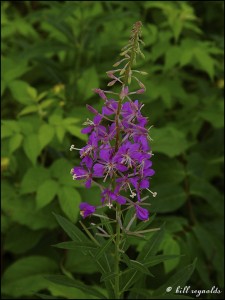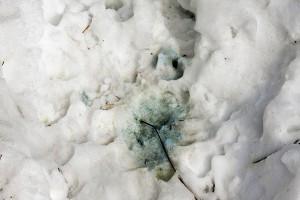 The first warm(ish) weather of 2014 called to me and I answered the call. I threw the snowshoes in the back of the Trailblazer and headed to the newly expanded West Unit of Savage Fen SNA.
The first warm(ish) weather of 2014 called to me and I answered the call. I threw the snowshoes in the back of the Trailblazer and headed to the newly expanded West Unit of Savage Fen SNA.
I parked near the wood SNA sign, put on the snowshoes, and walked the 130 yards to the information kiosk. Just then the sun came out from behind a thin but dense layer of clouds. I realized I did not bring my sunglasses so I went back to the Trailblazer and got them. By the time I got back to photograph the kiosk area the sun was once again hidden behind the clouds. That was the only sun I was to see all day.
 The kiosk area has a few well developed eastern redcedar trees. Packed snow and droppings beneath the trees indicate that this area is popular with whitetail deer. As I scanned the area I caught sight of movement near the south edge of the clearing. A deer approached the open area unaware of my presence. I managed to get the camera out without alerting the deer and took a couple of photos. Unfortunately, the only lens I brought was an 18-55mm wide angle zoom lens. This lens is good for landscapes but not for bringing distant objects closer. After a minute the deer saw me and bounded away.
The kiosk area has a few well developed eastern redcedar trees. Packed snow and droppings beneath the trees indicate that this area is popular with whitetail deer. As I scanned the area I caught sight of movement near the south edge of the clearing. A deer approached the open area unaware of my presence. I managed to get the camera out without alerting the deer and took a couple of photos. Unfortunately, the only lens I brought was an 18-55mm wide angle zoom lens. This lens is good for landscapes but not for bringing distant objects closer. After a minute the deer saw me and bounded away.
There were several deer trails to choose from leaving the kiosk area. I chose one leading south and then west. Before long I realized that the trail took me off of the SNA and I doubled back. I headed east following many deer trails showing little to moderate – but some – usage. Hard packed snow beneath the more recently fallen snow helps to support the weight of a person on snowshoes. It reduces by close to 50% (my unscientific estimate) the effort required for each and every step.
In the almost circular calcareous fen near the middle of the SNA I came across something I had never seen before. On the left (north) side of the deer trail the snow was 16″ deep and loose. On the right (south) side of the trail was an irregular shelf of yellowish ice rising 6″ to 8″ above the snow with little snow covering it. I tested the ice with my pole and it was thick and solid. A little farther on I came across another ice shelf, this one 8″ to 12″ above the snow with no snow covering it. A small area, no more than the size of a peanut butter jar lid, had visibly flowing water on top of the ice – a spring! The slow but continuous flow of water explains the irregular surface of the ice shelf.

Calcareous Fen
If a person falls in a ravine while wearing snowshoes and finds their legs and head in the air and their rump in the ravine, they will need to come up with a strategy to get themselves back on their feet. I’m just saying.

Seepage Meadow/Carr
Along with the one whitetail deer I saw several American Crows, two Wild Turkeys, and a hawk I was unable to identify. I heard Northern Cardinals, Black-capped Chickadees, Blue Jays, a Northern/Yellow-shafted Flicker (don’t get me started), and a Mourning Dove.

Deer’s-eye view of a buckthorn thicket
Total snowshoeing was 2.7 miles and 3 hours and 45 minutes. The high temperature in Savage today was 46°. By the end of the trek the snow on top was the consistency of wet sugar – heavy but still granular.












